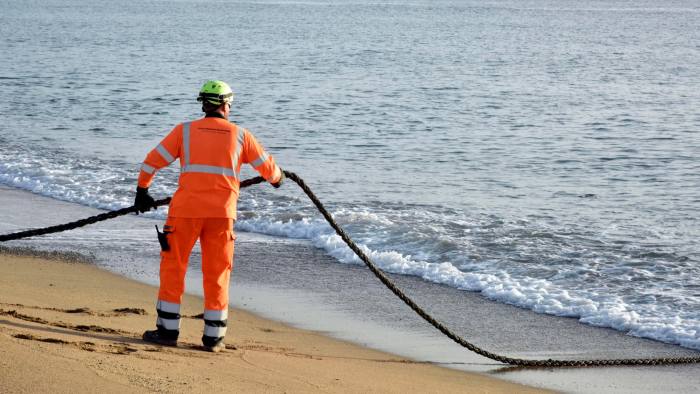To disrupt the internet connectivity in any country, including India, the enemy country or entity will just have to damage the majority of these cables.
NEW DELHI: By the end of 2021, the total volume of wireless data consumed by India was around 32,500 petabytes or around 32,500,000,000 gigabytes (GB). One thousand gigabytes make 1 terabyte and 1,000 terabytes add to 1 petabyte.
Over 95% of all the world’s digital data travels through undersea cables—a vast network of about 550 undersea-cable networks, lying on the sea-bed, measuring roughly 1.4 million kilometers, which is the size of a garden hose which covers and protects a human hair size filament that transfers all these data.
In India, these submarine cables, which are a part of a global network of cables that carry data, “land” at multiple places—Mumbai, Thiruvananthapuram, Tuticorin, Chennai and Kochi. Apart from these cities, another international landing station is coming up at Mundra, Gujarat, while there are two domestic landing stations at Chennai that connect Andaman and Nicobar Islands, and one at Kochi, which connects the 11 islands of Lakshadweep.
According to data, in India, by the end of 2022, 17 international subsea cables landed in 14 distinct cable landing stations across the different cities mentioned earlier.
The possibility of the colossal damage that can be caused to India’s economy by simply sabotaging these undersea cables, however, does not seem to have registered among relevant offices in India. Once anything like this happens, the authorities are likely to be caught unawares.
After the series of bomb attacks that targeted the Nord Stream gas pipelines in the Baltic Sea in September last year—which the US believes were caused by Russian saboteurs, the proof of which has still not been shared—security agencies across European countries are now exploring options to safeguard these vital data cable installations. They are worried about the disruption that will be caused apart from the large scale financial loss from a similar sabotage of the undersea data cables.
To disrupt the internet connectivity in any country, including India and thereby bring the entire country to a halt, the enemy country or entity will just have to damage the majority of these cables, the path and exact location of which can be easily identified. This will disrupt everything—from banking transactions and medical services to air and land travel, online booking, media production and government functions.
Damaging these cables, as some past incidents in the neighbourhood have shown, does not require advanced tools or weapons. All that it needs is coordinated effort at multiple pre-decided locations. A fishing ship manned by two trained men or an innocuous looking fishing trawler, from which a simple iron anchor can be thrown to the bottom of the sea at the exact spot where the cable is lying has the potential to break the backbone of the information flow network of the intended country.
Last month, two undersea internet cables linking Taiwan’s main island with the Matsu islands were severed within less than a week. According to Taiwanese officials, Chinese vessels were behind the act which ensured that the 14,000 residents of Matsu island were left without any phone or internet. The internet connectivity to these islands is likely to become normal by the end of April.
As per Taiwanese officials, the cables linking Taiwan’s main island with the Matsu islands, the Quemoy islands, the Penghu and other islands—and also linking those islands with each other—have been damaged at least 30 times through human activity since 2020. Twenty-one of the 30 incidents in which the cables were severed were caused by fishing boats or sand dredgers. According to TeleGeography, a telecommunications market research and consulting firm, the normal global instances of such cable breaking are 100, which confirms that these Taiwanese cables were being “broken” by intent as a part of an “undersea cable war”.
Among the countries that have woken up to this threat not just from China but also from other-state backed actors (as is suspected in the sabotage of Nord Stream) is Japan, which last year introduced a specific budget provision to do timebound research on the measures it needed to take to safeguard these undersea cables.
Similarly, the French government released money under the head “ocean floor defence” post the Nord Stream pipeline attack, to protect its ocean floor assets that include undersea cables. The French government also constituted a task force that will report to the French President. It also has invested money in purchasing two unmanned underwater vehicles whose sole objective is to protect the undersea cables that connect France to other countries.
However, nothing on these lines is on the anvil so far as India is concerned, despite a few voices taking up the issue. In May 2021, the then Indian ambassador to France, Jawed Ashraf and Australian ambassador to France, Gillian Bird had penned a joint opinion piece for the French newspaper, Le Journal du Dimanche, in which they had stated among other things, “The Indo-Pacific region has the busiest international shipping lanes, a dense network of submarine cables, and a growing constellation of satellites in space. These assets face threats that will have consequences for global security and the economy.”
A recent paper titled, “Submarine Cable Security in the Indian Ocean”, which was published by the National Security College, Canberra, highlighted how it was imperative for the governments of France, India and Australia to come together to cooperate to safeguard the undersea cables in the Indian Ocean Region. The paper also makes it clear that while France and Australia are taking proactive steps, including military and related to cybersecurity, India is yet to take any such initiatives.
The Sunday Guardian reached out to the Minister of Information Technology Ashwini Vaishnaw and the department secretary through email seeking their responses on the steps, if any, the ministry was taking, to safeguard these undersea cables. No response was received till the time this report went to press.

